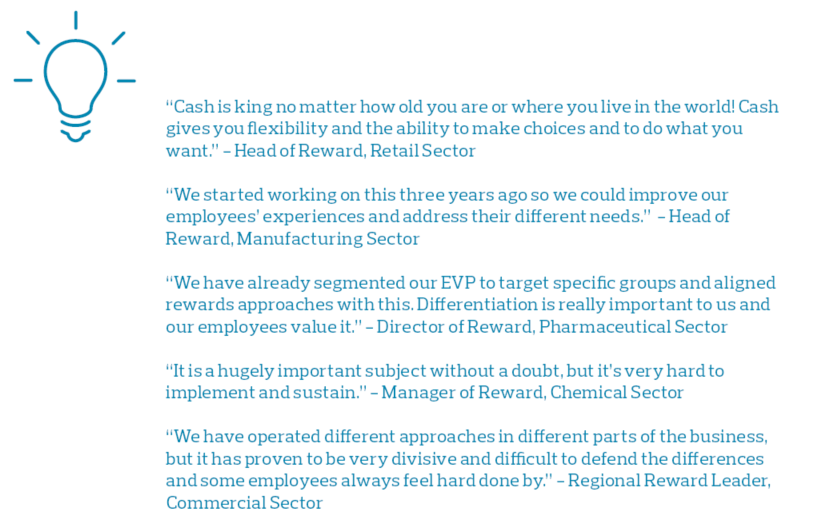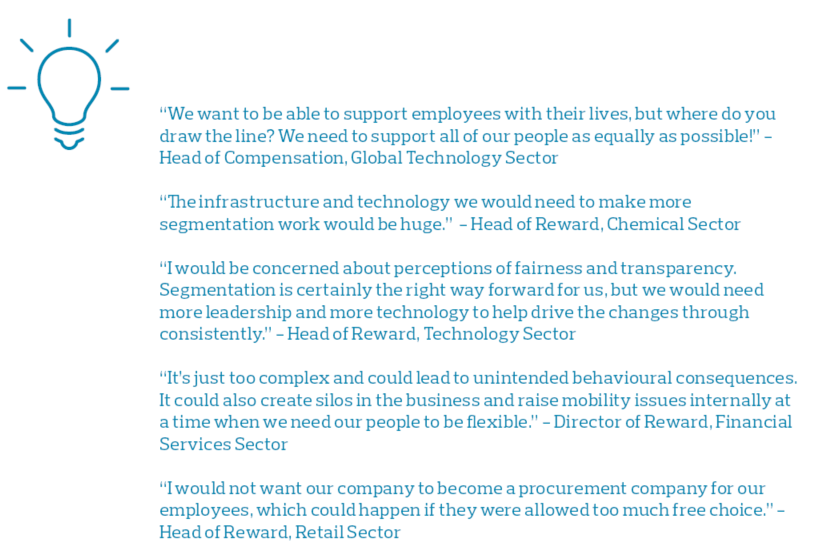In the second article of our European Leaders in Rewards series, we discuss the benefits and risks of rewards segmentation and its potential impact on employee engagement.

In the first half of 2020, Aon held interviews with over 50 senior rewards professionals from some of the best-known brands and employers across Europe. Their opinions were sought on three different topics, which we examine in three separate articles. The first article looked at the role of analytical job evaluation schemes in the modern world of work. In this article, we consider the potential segmentation of rewards as an engagement tool. The final article contemplates whether rewards functions are benefitting from the digital revolution similarly to other business areas.
Through the course of our discussions, we hope to raise important questions and debate around the future of rewards and how organisations can optimise investment in their people.
Why Segment Your Rewards Approaches?
There has been a great deal of debate over the years on the topic of whether rewards can truly motivate and engage individual employees. In fact, some even argue that those who are motivated only by pay, may not be the types of individuals they want to employ in the first place. Supporters of Herzberg’s business motivation research claim that pay can only ever demotivate and that real engagement comes from the non-financial parts of a rewards package — this remains a compelling line of argument for many today. Employee research in recent years is remarkably consistent in showing that non-financial elements (including engaging work, learning new skills and career development) dominate the top rankings in lists of essential factors for employee engagement and motivation.
Rewards are one of the largest costs faced by many organisations. Without fail, these costs climb by a few percentage points almost every year. However, there has been a recent change in perception that came to the forefront during the last recession. Previous attitudes were centered around the concept that rewards costs were just that — costs. But this mentality changed as organisations looked for ways to leverage that cost to help them survive during difficult economic times. Employers instead began to view rewards as an investment with the potential to deliver an upside for the business. Like all investments, the challenge then became truly realising the potential of that investment. Organisations have spent a great deal of time and energy trying to answer this question within their own context: How can they more effectively leverage the money they are investing to help improve performance?
Company-wide developments were identified as having only limited impact on motivation at the individual employee level. Organisations quickly came to realise that every employee was unique with a different set of needs and aspirations, even when they shared a common demographic. If a firm wants to deliver a compelling and engaging rewards proposition, it needs to be tailored to that employee as much as possible. Therein lies the common issue we see today.
The Challenge of Finding the Right Balance
While tailoring the package to meet individual employee needs has possible benefits, it also has a number of significant drawbacks. To begin, allowing room for increased levels of personal choice creates complexity, which could inhibit transparency and make communication more challenging. In an environment with many bespoke rewards arrangements, there are additional concerns around the management and demonstration of pay equity — an issue that, for many, is far too important to ignore. As a result, many organisations use flexible benefit schemes (particularly in the UK) as a way of delivering choice to an employee in a fair, equitable and transparent manner.
Firms may also take the approach of segmenting small groups of roles, providing catered treatment depending on the function (e.g., sales). The issue of segmentation is particularly pertinent today as we approach another global recession and employers look once again for ways to strategically leverage their spend. As a result, we are seeing an increasing number of firms revisit this topic. Businesses that seek to engage and motivate individual employees by enabling them to choose a proposition that fits their own personal circumstance, are battling against the complexity of this task, its potential administration burden and the equity and legal implications of going too far. It is all a question of balance: How much choice can they offer before risking any of the downsides?
To discuss this further, we asked participants for their views on how they expected practices and thinking in this area to evolve in the coming years. We began by exploring the level of segmentation that already exists within their firms and whether they felt the concept has a potential business value-add. As seen in some of the direct responses below, the opinions were clearly divided:

Facing Segmentation Risks
Whilst opinions on the benefits of segmentation varied, there was consistent agreement that successfully delivering this approach in today’s economy is highly challenging. When participants were asked about their current practices, the most common areas of segmentation and personal choice were, unsurprisingly, related to benefits — specifically fringe benefits given that core elements are often protected, to a degree, by national regulation and controls. There were also obvious instances of segmentation by function, level and geography, as might be expected, but when it came down to personal choice, there was little in the way of new practice. However, there are a number of clients we spoke with who intend to look into this further and challenge the market norms.
The issue with implementing this new tactic is that someone must go first. Whilst we might all recognise the concept of “first mover advantage,” there is a real fear that the risk of a disadvantage outweighs the potential benefit. This scenario is clearly not conducive to change, as organisations look to each other to see who will take the first step.
When asked about their concerns and the risks they might face with segmentation, participants’ responses were mixed. Some were clearly not supportive of the approach as outlined above, and those who remained more positive still had legitimate concerns:

As organisations look for ways to get more from their investment in their people, the topic of segmentation will remain at the forefront along with concerns over its implications. In our research, we found that even the most positive supporters and advocates of the approach had similar apprehensions to those expressed above. So, what does the future hold for segmentation and will increased engagement through more employee choice ever become a reality? We asked participants for their views, and the majority still expect to see more segmentation moving forward. They described it as “a clear direction of travel” and a “topic that just isn’t going away.”
Beyond employee engagement, segmentation also appears to have direct link to the war for talent. This was explained by a reward director in the technology sector, who commented, “How do we compete for talent in an increasingly crowded marketplace? — By offering the talent what they specifically want and need!” One participant also connected segmentation to evolution of the employee/employer relationship, growth of the gig economy and the recruitment of more individual contractors all negotiating their own terms and conditions.
Additionally, participants commented on the nature and degree of segmentation and personalization, with many clearly anticipating more choice for employees. Other leaders commented that they would like expand employee choice through their pay and the balance between fixed and variable, offering a higher upside for those who choose more variable pay, although the equity and complexity challenges of this concept cannot be ignored.
Next Steps
The debate and potential impacts are clearly wide ranging. What started out as a discussion with participants on employee segmentation and engagement quickly moved into other areas including:
- Talent management
- Equity and perceptions of fairness
- The need for more technology
- Leadership behaviour
- The growth of the gig economy
- Local regulations and constraints
- The need for simplicity and transparency
- The risk/return of being an early mover
- Generational differences and expectations
Overall, there was a widespread acceptance and belief that rewards serve as a motivator and can be engaging (as you might expect given the roles of the participants), but the journey to deliver this is where the perceived issues manifest.
For some, it is enough to offer employees as much cash as they can and enable them to make informed personal choices on how they utilise it. For others, there is a real desire to offer employees a more rounded and personal approach, as they aim to support the lifestyles and personal choices of all their people. Regardless, this topic is here to stay. With another global recession on the horizon, we can expect to see more organisations looking for creative ways to motivate their people and gain a return on their rewards investment. For the time being, though, this will likely not sway from the usual options. However, if just one company chooses to break out and fully commit to widespread segmentation, this path could change. All it will take is finding a solid way to harness the benefits whilst managing the downsides and risks for others to follow suit.
For questions about the topics discussed in this article please contact one of the authors or write to rewards-solutions@aon.com.
Related Articles